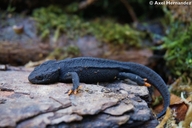|
Tylototriton liuyangensis Yang, Jiang, Shen & Fei, 2014
Liuyang Crocodile Newt Subgenus: Yaotriton | family: Salamandridae subfamily: Pleurodelinae genus: Tylototriton |
| Species Description: Yang D, Jiang J, Shen Y, Fei D 2014 A new species of the genus Tylototriton (Urodela: Salamandridae) from northeastern Hunan Province, China. Asian Herp Res 5: 1- 11. | |
 © 2015 Axel Hernandez (1 of 1)
|
|
|
Country distribution from AmphibiaWeb's database: China
Author: Axel Hernandez Tylototriton liuyangensis YANG, JIANG, SHEN, & FEI 2014
Diagnosis and taxonomyThe species name is derived from the locality where it was found. The holotype (HNUL 11053108) is an adult male from Chuandiwo (28°25'N, 114°06'E, at 1,386 m a.s.l.) in the Liuyang Daweishan Provincial Nature Reserve, northeastern Hunan Province, China, in May of 2011, and it is complemented by a paratopotypic series of adult females (HNUL 11053110, HNUL 89070502–4 and 89062900) and two adult males (HNUL 89070505 and 89070501) that had already been collected in June and July of 1989. Additional topotypes include seven adult males (HNUL 110601F02–4, 110601F06, 11053108–9 and 11053116) and two adult females (HNUL 11053110 and 110601F01) collected in May and June of 2011. The holotype and some paratypes were deposited in the Animal Specimen Museums of the Hunan Normal University and the Central South University of Forestry and Technology, both in Changsha, Hunan, and (n=2) in the Herpetological Museum of the Chengdu Institute of Biology of the Chinese Academy of Sciences in Sichuan, China, respectively. These two latter paratypes were examined by the author in 2015. Based on molecular studies, T. liuyangensis is the sister taxon of T. lizhenchangi within the same clade. Concerning its morphology, T. liuyangensis is superficially similar to T. lizhenchangi but smaller. Males measure up to 13.0 and females up to 15.5 cm TL. The latter are more robust and larger than the males. This species is characterized by a rough skin, depressed head with a short, rounded snout, a few prominent bony ridge surrounding the upper side of the head, a short median cephalic ridge, parotoids laterally projecting, body slender, vertebral ridge low and wide, 15 to 16 small yet distinct and dorsolateral glandular warts, skin rough, wrinkled transverse grooves on the belly, and a sharp upper caudal keel. Its coloration varies from black to dark brown above and lighter on the ventral sides, and the lower edge of the tail, cloacal region, and ends of fingers and toes are yellowish orange (YANG et al. 2014). The Liuyang crocodile newt has a series of morphological characters that set it apart from other species of the genus Tylototriton: 1) comparatively wide interorbital space; 2) bony ridges on the dorsal side of the head going through the upper eyelids; 3) a comparatively large space between axilla and groin (AGS), with the mean male AGS being approximately 50% of the SVL and mean female AGS 53% of SVL; and 4) “a small genital armature on the anterior angle of the labial folds found inside the anal fissure in male during the breeding season” (as per the translation provided by YANG et al. 2014).Some chromatic variation was observed in the natural habitat, which seems to be a function of the newts being or not being in breeding mood and will lighten their colors during the breeding season period much like in T. vietnamensis. DistributionThe species is distributed from an area of only 150 km² in northeastern Hunan Province east to the Liuyang Daweishan Provincial Nature Reserve (today the Dawei Mountain National Forest Park), suggesting that its actual distribution could extend from northeastern Hunan to northern Jiangxi Province, where I found a similar form in the Hu Pin Shan (mountains) in 2015.This species used to be considered a population of T. wenxianensis in the past, and old records under this name from eastern Hunan could in fact refer to T. liuyangensis. Habitat, ethology and ecologyThe holotype was found at 1,386 m a.s.l., which suggests that this species lives at greater elevations than most of its congeners. Humidity hovers around 85% throughout much of the year, and average temperatures do not exceed 11.4 °C from October through April and reach 20.0 to 23.9 °C between May and September. The ecology and ethology of this species are hardly known due to its having been discovered only recently.ReproductionThe reproduction of this species plays out in ponds and shallow streams formed by the monsoon season from early May through June. The spawning site is surrounded by dense grasses with swamps or ponds. The eggs are solitary, and arranged in a sheet. They ranged from 7.8 to 8.1 mm in diameter (including egg film). The ova are yellow. Larvae have a body covered with dense black variegation, whereas the abdomen has less variegation and is lighter in color.Captive husbandryHusbandry requirements are probably similar to those of the closely related species of the supraspecies wenxianensis.Status, threats and conservationThis species is threatened by large-scale farming of the famous "black" peanut that is very prominent in the region. However, the Liuyang Daweishan Mountains are a protected area. While its status has not been evaluated by the IUCN, I recommend regarding T. liuyangensis as “Endangered” because of its small distribution and poaching for the pet trade.Complete BibliographyFeedback or comments about this page.
Citation: AmphibiaWeb. 2025. <https://amphibiaweb.org> University of California, Berkeley, CA, USA. Accessed 16 May 2025. AmphibiaWeb's policy on data use. |



 Map of Life
Map of Life